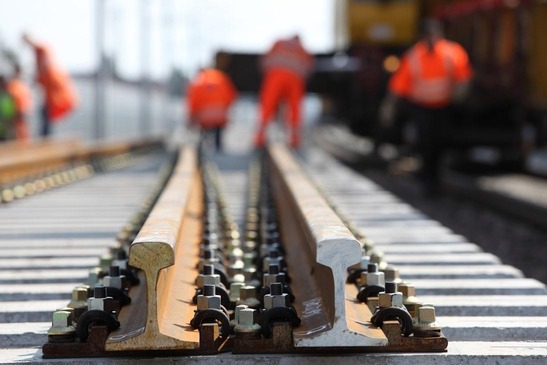
Area 2 research activities will enable Rail4Future vision by: Provide explanation & generate understanding of the railway system interactions and the underlying reasons of the specific behaviour of railway tracks and its impact on rail vehicles by means of basic research enhanced by novel digital twin methodologies combining different sources of data and advanced computational models.
D2.1.1 Report on Sub-Model Development
Components of the railway system such as rails, sleepers, ballast, switches and crossings etc. are exposed to a multitude of environmental and operational influences. The cyclic loading of rails results not only in a continuous track settlement by transferring the loads from the rail down to the sleeper and the ballast but also lead to wear and rolling contact fatigue (RCF) on rails and wheels. To describe the behaviour of the track superstructure several complex mechanisms are acting in parallel and have to be understood in detail.
D2.1.2 Report on Hybrid Simulation
In this report the work on hybrid simulation is described by using different approaches to simu-late the degradation of single switch/track components. Furthermore, the developed methodol-ogies are extended to calculate the degradation of a specific track section or a whole track network.
D2.2.2 Report of Requirements
The first part of the project contains the definition of necessary data and methods. The three streams need partly different, but also overlapping and similar data. In order to figure out, which data need to be achieved from where, the research partners have to document their needs.
D2.2.3 Report on available historical Data and identified further required Data
D2.2.5 Report on the descriptive Model (included in D2.2.3)
The descriptive approach should provide verified prediction algorithms and trend analysis concepts for turnouts. These algorithms need to be derived on a sound data basis. For this reason, in the first project phase, necessary data for further work were defined and requests were made to the corresponding project partners. In the following, we address this data and show to what extent this data is available.
D2.2.3 (D2.2.5) Report on available historical Data and identified further required Data - TU.pdf - Paper 1
D2.2.3 (D2.2.5) Report on available historical Data and identified further required Data - ViV.pdf - Paper 2
D2.2.4 Report on Data Quality and Generation Concept
Turnouts are one of the most stressed and safety-critical components of the railway infra-structure. The assessment, regarding necessary maintenance or renewal is made based on visual inspections of qualified employees. One of the aims of this project is to aid this time and cost intensive approach by utilising measured data and advanced algorithms to reduce time and cost.
To this end, additional sensor modalities are installed on the measurement locomotive EM100VT of Plasser & Theurer.
D2.2.6 Report on hybrid approach algorithm
D2.2.7 Report on prediction algorithms
D2.2.8 Report on deployment and demonstration
Although one of the most operation-critical and highly stressed components of the railway track (due to dynamic impact loads and slip), decisions regarding necessary maintenance activities and renewals of turnouts are still made based on visual inspections. One of the aims of the project is to advance the condition assessment of frogs using measurement data enriched with simulation results and thus to provide the responsible railway staff a tool supporting their decision-making processes. This report contains of the hybrid approach algorithm (D2.2.6), the prediction algorithms for the descriptive approach (D2.2.7), and the deployment and demonstration (D2.2.8). The latter is already included in the different approaches, so this report shows the final results of the two different descriptive approaches and the hybrid one.
D2.3.1 Report on the currently available test methods and test systems
Continuously welded rails (CWR), as found in the current railway network, have become the standard in recent decades. Compared to rails with gaps, CWR are easier to maintain and can accommodate higher speeds. Additionally, CWR result in reduced wheel wear and longer rail lifespans. However, temperature fluctuations cause longitudinal stress in the rails due to their inability to expand or contract adequately due to welding. In extreme cases, this stress can lead to rail fractures in low temperatures or track buckling in high temperatures, both of which have caused train derailments in the past. To mitigate risks during critical temperatures, train speeds are reduced, leading to economic losses and delays. Understanding the rail condition and assessing stress levels became crucial, thus introducing the concept of Neutral Temperature (NT).
D2.3.1 Report on the currently available test methods and test systems.pdf - German only
D2.3.2 Report on Concept for Signal Evaluation and Signal Interpretation (M24)
For the preliminary studies, a test rig had to be invented in order to apply tensile and compressive force on a rail sample. With two hydraulic presses (each capable of 500 kN compressive force) and a relocatable crossbeam this requirement was met.
D2.3.2 Report on Concept for Signal Evaluation and Signal Interpretation.pdf
D2.3.3 Suitable test configuration defined (M33)
As part of Condition Monitoring with Smart Assets, preliminary tests have shown that reproducible and systematic correlations between the longitudinal tension in the track and the track condition can be made visible. As part of the outlined measurement campaign, three previously tested methods are to be examined for their applicability in the installed track.
D2.3.4 / D2.3.5 Implementation of measuring devices and concepts evaluation (M42)
From the 8th until the 12th of April 2024 the field measurement was carried out near the village “Raasdorf” east of Vienna, Austria at a straight track section. The overall goal was a verification of the laboratory measurements of the Fraunhofer IZFP. For this purpose, the longitudinal rail forces occurring during the measurements had to be determined.
D2.3.4 / D2.3.5 Implementation of measuring devices and concepts evaluation (M42).pdf
